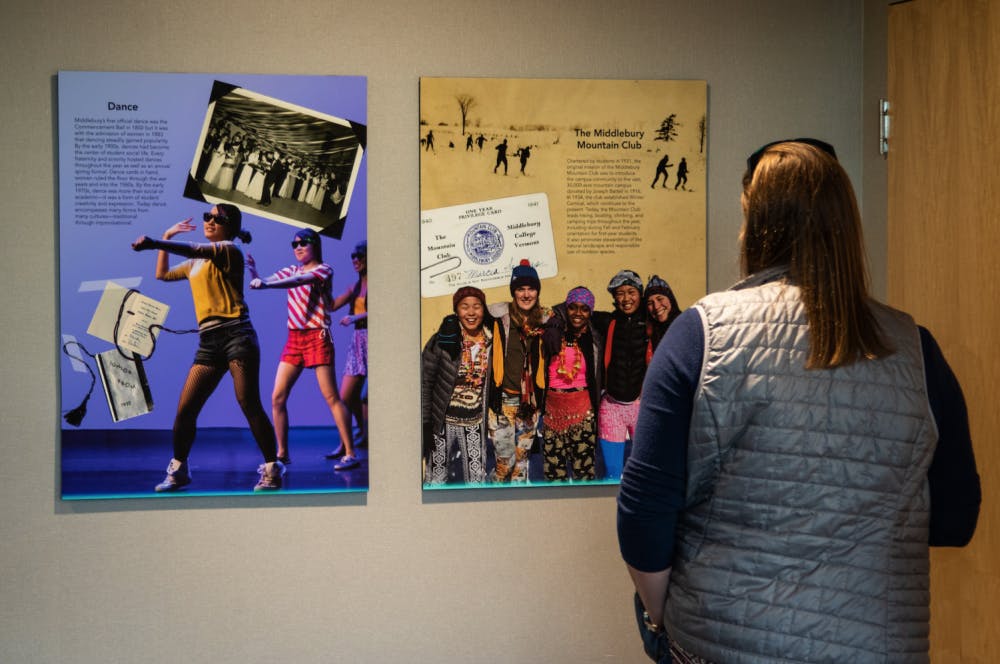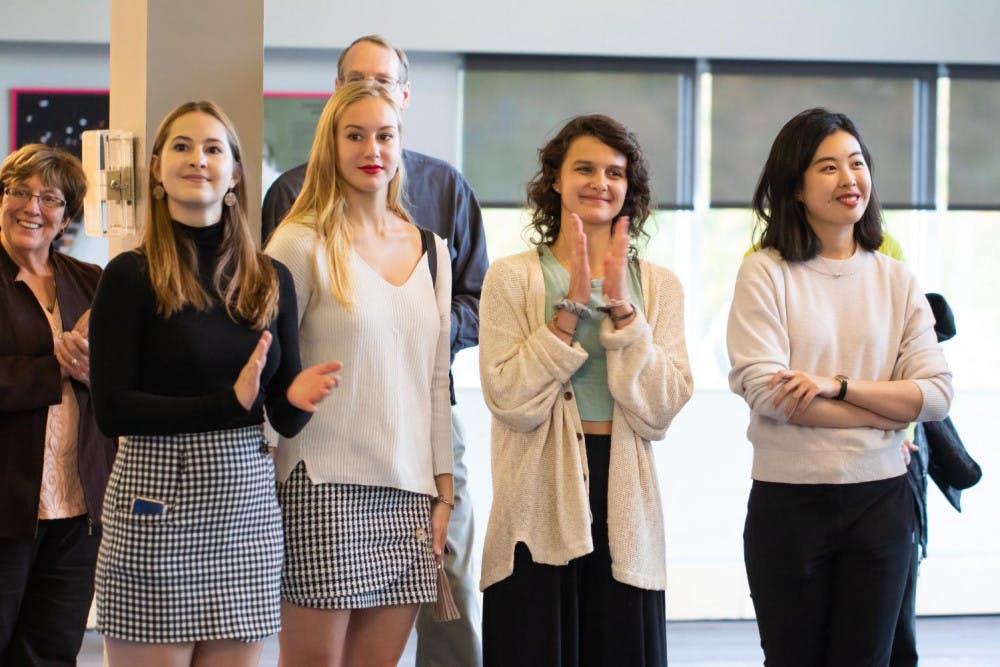Inside Kirk Alumni Center, a colorful panel on the wall includes two photos of club activities and two paragraphs outlining the evolution of social landscapes at Middlebury College, all on the background of a photo showing a group of students dissecting pig feet.
The neatly designed collage-style panel is titled “Living Together: Social Life.” At first sight, pig dissection may seem to many, including President Laurie L. Patton, more like a classroom activity.
“We heard that this is the Pre-Med Society, whose idea of fun gatherings outside the classroom is dissecting pigs,” Patton said at the exhibit opening on Oct. 26 to an amused audience. “Go, Midd.”
The panel is one of more than a dozen featured in the new exhibition “Continuity of Change: Living, Learning, and Standing Together,” an exhibit that looks at the history of the college from the student perspective. The exhibit was curated by a group of six interns of the 2018 MuseumWorks, an intensive summer internship program supervised by Jason Vrooman ’03, curator of education and academic programs of the College Museum of Art.
“[The exhibit] is Middlebury’s story told through the hearts and minds of its students, and it looks to a future where diversity and inclusivity is Middlebury,” said college archivist Danielle Rougeau, who co-supervised the project.
Throughout the eight weeks, the interns met every Monday with Rougeau to go over huge amounts of archival materials of the college’s history, from scrapbooks and photographs to student publications and official reports, attempting to understand the past, present and future of Middlebury. The team wanted to formulate a narrative that, according to intern Jessie Kuzmicki ’19, “was true and also aspirational.”
“I think we all are in agreement that Middlebury is a pretty awesome place, and I think we always strive to be positive,” Kuzmicki said at the opening. “We always try to do the right thing.”
Student activism constitutes an important element of the exhibit, with several panels dedicated to various points in time in the college’s history of student protests. One shows student protestors outside Mead Memorial Chapel after the election of Donald Trump in 2016. Another explains the organized “Die-In” in Ross Dining Hall in December 2014 after Eric Garner and Michael Brown were killed by police earlier that year.
The challenge to represent Middlebury’s 218 years of history in one small exhibition was always present during the curatorial process. Elizabeth Warfel ’19 said that they were “constantly bombarded with new ideas,” trying to figure out what direction the exhibit should take and what to include in it. Warfel also appreciated being able to work with not only Art History majors, but also with English and History major Kuzmicki and Theater major Sam Martin ’19.
Unlike other interns who worked on other projects at local museums or libraries, Martin worked on the exhibit full time and helped design the panels in Photoshop.
“I do a lot of work in theater and design for the stage,” Martin said. “It was really exciting to bring about what I’ve learned about visual storytelling and aesthetics of this exhibition.”
He explained that the design of the panel in a relatively free collage-style is intentionally challenging the previous exhibit on view at Kirk Center, which consisted of mostly historical black-and-white photos.
“It’s really meant to look like something students made with paint, glue and tape and just put up [by] ourselves,” said Martin. “I hope it’s empowering to the students to take control of our narrative of Middlebury and what we want it to be.”
Part of what made the exhibit possible was, according to Rougeau, the interns’ dedication to understanding Middlebury’s evolution throughout the years and to place their own experience in that context. Exploring the diverse panels, there is no doubt that this sense of continuity shines through. Elements one might find familiar include dance performances in recent years and clippings from The Campus.

The exhibit looks at the history of student social life and extracurriculars.
At the same time, viewers are guaranteed to find something new and unknown to them in the exhibition. On the panel titled “The Women’s College,” various images and scans of documents illustrate the prevalence of gender inequality both in the past and present, the students’ struggle against that, as well as a little known attempt to build separate campuses for women and men before the administration gave up the idea in 1950.
Above a photo of The Feminist Resource Center at the Chellis House and another of student protests marching outside Ross, three headshots of women are accompanied by notes, written or printed in the 1930s, outlining their “offenses” and the punishments they received. All three had their rights for “nights out” taken away for a couple days because of misconducts like “entertaining in a classroom at the Chateau with the lights out and the door closed” or “smoking on campus.”
“It’s a wonderful view into how women are treated differently than men, the rules that dominated their lives and did not pertain to men,” Rougeau said, explaining that these particular materials came out of what she called “miscellaneous historic topics” consisting of important stories that do not necessarily fit into the archive’s record groups.
The exhibit initially stemmed out of conversations between the MuseumWorks program, the Alliance for an Inclusive Middlebury and the president’s office to redesign the Kirk Center, and bringing the college’s archives to life in the long run is a crucial part of that.
Rougeau is excited that the archive materials are becoming part of the curriculum, as there is generally an increasing awareness of the importance of going to the primary sources in the country. Yet the exhibit marks the first time where “archives is the impetus.”
Having the exhibit at Kirk Center, Rougeau said, does bring limitation to its availability, as it is an alumni center that is only open when they host events. Meanwhile, the Special Collections room in Davis Family Library is always open to interested students.
“We are open five days a week, [and] anybody is welcome to come here,” she said. “We are hoping that through curricular exposure that there will be a genuine curiosity among the students themselves to come and do their own research.”




